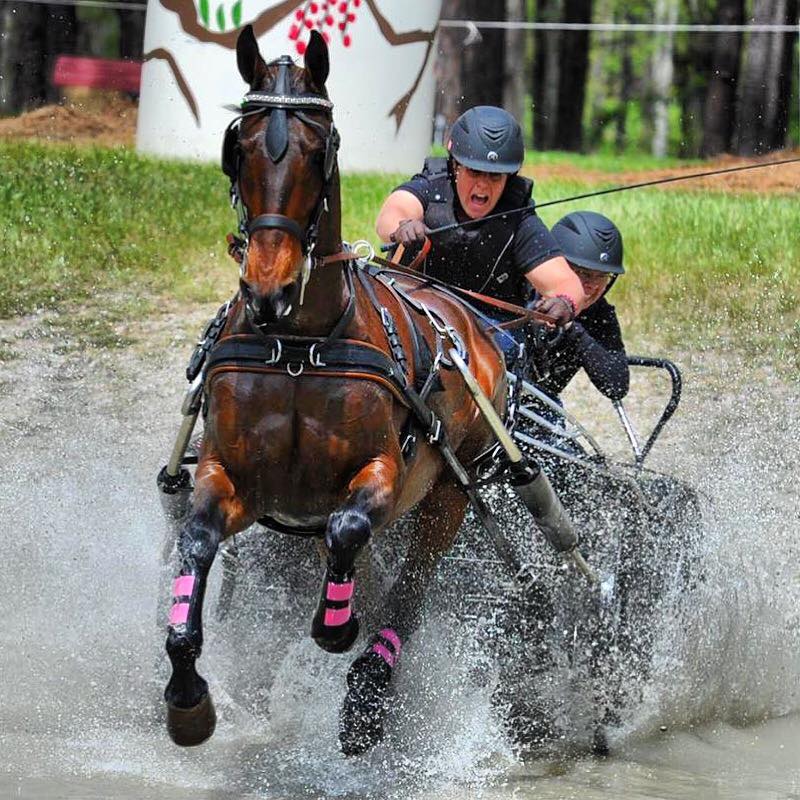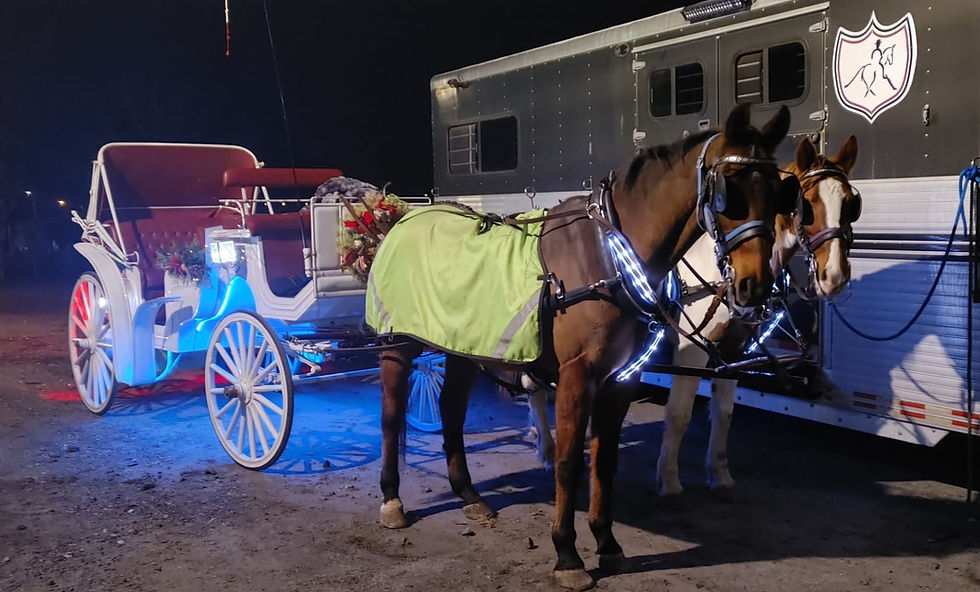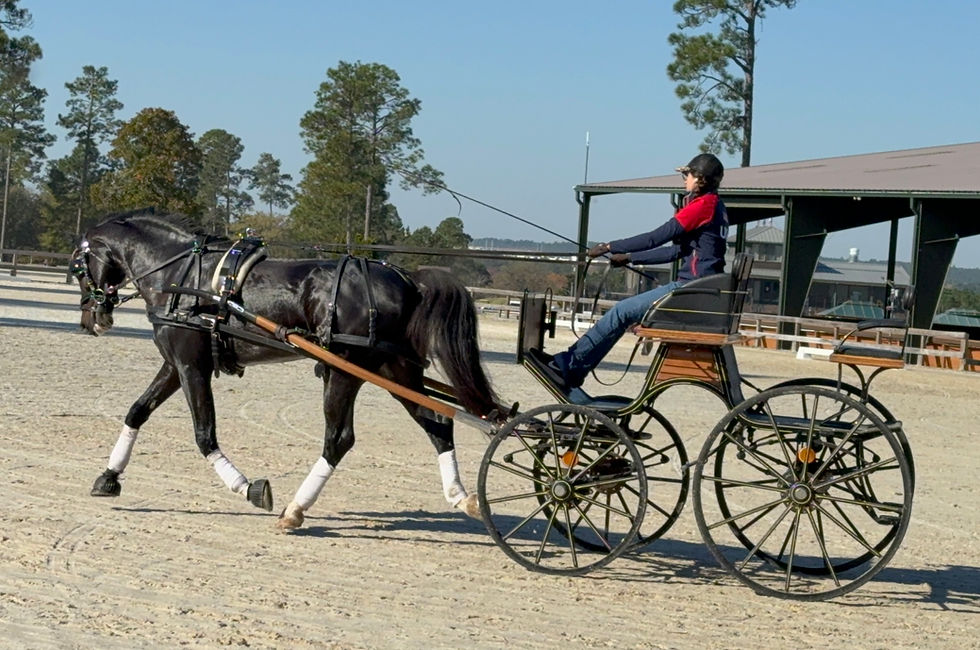Long Lines / Double Lungeing 101
- jess3152

- Jul 1, 2022
- 4 min read
Updated: Jul 3, 2022
Longlining (aka double lungeing) is a training method that has been used for centuries to help teach the horses new skills without the complication of a rider’s weight added to the mix. It is exceptionally beneficial to training the driving horse as it is literally driving them, from the ground, without the complication of a carriage attached. The horses can learn to move forward, go straight, accept the bit, stop, turn left and right, leg yield, and follow directions from the voice of the trainer. The possibilities are endless with longlining and that makes it a crucial part to the training and maintenance of any driving horse. Forward motion is the key to straightness, straightness is the key to bend, bend is the key to steering, and the training pyramid continues (that’ll be a blog post for another day).
There is no right or wrong length of time or frequency to longline your driving horse. It is more about confirming basic skills needed to drive safely and successfully, along with fine tuning movements that might be a little easier for the horse to work on without also towing the weight of a carriage behind him. It takes a little bit of time to be confident with 2 lunge-line-length reins in your hands and manipulating the horse with those reins, but with some practice and commitment you and your horse will longline like pros.
-Equipment needed:
Obviously, you’ll need longlines… The longlines I like the most can be ordered from my friend, Vijay, through his Ebay store. Here is a link: https://www.ebay.com/itm/Leaders-Training-Reins-for-Lungeing/255364384966 In the video with this post I’ll explain why I like these longlines the best compared to using 2 lunge lines or any other long lines I have used (and I’ve been through a LOT of longlines in the last 16 years)
I have used training surcingles specific for longline and lungeing use, but I find that with the driving horse, I most prefer to just use my driving saddle. I use the tugs for the rings to run the longlines though, and it makes the most sense to work with what we’ll be using on the horse when we put him to the carriage as well.
Properly fitted bridles are very important, especially your bit. I often see people lungeing and working horses from the ground in snaffle bits that are being pulled through the horse’s mouth. You want a bit that will not be pulled through the mouth with side to side pressure. If you must have a snaffle, I suggest half cheek snaffles, full cheek snaffles, and D ring snaffle cheeks. I prefer to longline everything in their driving bridles and Liverpool bits. All horses (the exception being minis and small ponies) in my stable work in liverpools… and everyone always in bridles with blinders. If you’d like to know why… check out my bits and my blinders blog posts 😉
-How to begin to work the horse around you:
When teaching someone new to longline one of my favorite things to do is draw with spray paint about a 3’ diameter circle on the ground. That is the circle your body is to stay in. Remember, the horse is supposed to be longlining and lungeing around you, not you running around behind him and practicing fancy foot moves -save those for the dance floor. Also, always keep your feet moving one in front of the other instead of taking steps backwards with your feet. We always want the horse going forward (forward is the key to straightness, straightness is the key to bending -you remember that from up above) and when you keep your own feet going forward, it will translate to the horse. Trust me. I’ve been lungeing horses longer than I can remember. This also will help keep you from getting tangled up in your reins. You also can’t see behind you… If you keep stepping backwards, eventually you’re going to trip and fall down; in my experience, the horses generally don’t find that amusing.
If the horse is getting too close to you and you feel like you need to step backwards, it means you need more outside rein. It also will usually indicate your horse needs to go more forward. Give him a click or whatever sound you use to represent your leg and going forward, half halt the outside rein, and send him forward. I promise you with a proper half halt on the outside rein and a click forward, you’re horse will step right up and out away from you.
There is so much on this art. I could go on and on for days. I love to teach longlining and have some very cool horses that can shorten to the most collected of trots and extend to the biggest of extended trots on the longline if you ever get a bug to come for a longline lesson. There’s a hole world of opportunities to be achieved on longlines and it’s a great way to refine your driving skills and get your horse fit and ready for the carriage.
Here is the video I did for an intro to longlines, please watch it and note the positioning of the reins around the horse’s body. It is for SAFETY that your outside rein needs to always be around the hind end of the horse and I will explain that further in the video. Enjoy!




I just did some long-lining this week with my two girls… I too have found so much can be accomplished filtering this “gymmastic” in between my ridden and driven endeavors which can make the work easier or more understandable! I have always loved the work on the longlines and it’s benefits… This week with both of my horses worked on forward and straight but yet staying calm and level headed…
I can’t wait to get my new longlines so I can use my driving bridles and their Liverpool better!